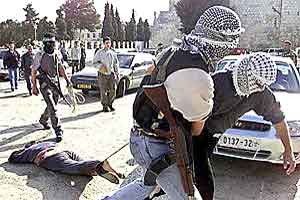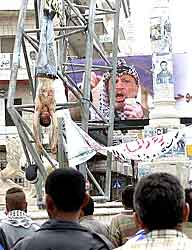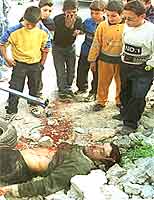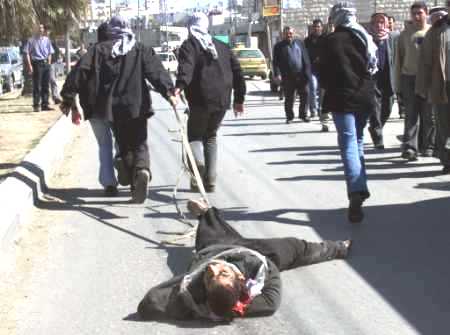

"Palestinians" killing "Palestinians"
Palestine Royal Commission Report said "toleration by the Government of subversive [terrorist] activities, more especially those of the Mufti of Jerusalem,"1 included not only terrorism of Jews but also of moderate Arabs and those effendis engaged in a power struggle with the Islamic leadership. As the Palestine Royal Commission Report had observed, with uncharacteristic indignation in 1937, ... intimidation at the point of a revolver has become a not infrequent feature of Arab politics. Attacks by Arabs on Jews, unhappily, are no new thing. The novelty in the present situation is attacks by Arabs-on Arabs. For an Arab to be suspected of a lukewarm adherence to the nationalist cause is to invite a visit from a body of "gunmen." Such a visit was paid to the editor of one of the Arabic newspapers last August shortly after he had published articles in favour of calling off the strike." Similar visits were paid during our stay in Palestine to wealthy Arab landowners or businessmen who were believed to have made inadequate contributions to the fund which the Arab Higher Committee were raising to compensate Arabs for damage suffered during the "disturbances." Nor do the "gunmen" stop at intimidation. It is not known who murdered the Arab Acting Mayor of Hebron last August, but no one doubts that he lost his life because he had dared to differ from the "extremist" policy of the Higher Committee. The attempt to murder the Arab Mayor of Haifa, which took place a few days after we left Palestine, is also, we are told, regarded as political. It is not surprising that a number of Arabs have asked for Government protection.2The Associated Press ran this story, "Palestinians Face Internal Violence" on March 16, 2002 BETHLEHEM, West Bank (AP) -- One was strung up by his heels in the middle of a downtown traffic circle. The battered body of another was dragged through the streets before assailants tried to hang the corpse from a rooftop overlooking the traditional site of Jesus' birth. Two more were snatched off a West Bank road, driven to a deserted slaughterhouse and riddled with bullets. Assisted Suicide MartyrsAn even more disturbing trend is that there is increasing evidence that "Palestinians" are killing "Palestinians" not only for collaboration with Israel (which could mean as little as buying and selling an Israeli product), but also for bumping up the numbers of "martyrs" for the "Palestinian" cause.
Using forensic evidence to try and trace the source of the bullets themselves would be complicated by the fact that the Israeli Government authorized the transfer of thousands of guns to the Palestinians, for use by the Palestinian Police force. “We have no problems with weaponry since we have enough guns that were given to us by Israel,” stated Abed el-Qader, Senior Tanzim Leader on March 8, 2001.
The mayor of Hebron, Nasr
el Din Nasr,
murdered August 4, 1936, was a close ally of the Mufti's chief
opponent,
Ragheb Bey Nashashibi; the wife and daughter of the mayor of Bethlehem
were wounded July 1937; the mayor Nablus, Suleiman Bey Toukan, who
publicly
warned the government of chaos if terrorism was not squelched, fled
after
attempted assassination in December of 1937. No fewer than eleven
mukhtars
were slain, along with family members, between February of 1937 and
November
of 1938.
"During the same period,
attempts were
made on the life of the Mukhtar of Lifta Muslim religious leaders
murdered or wounded
included the following:
Other Sheikhs who were
murdered then by
Arab terrorists included:
A similar list of "moderate" Arabs, including Anwar Sadat, etc. who have been exterminated recently by the Militant Palestinian Groups-the modem "Muftism"--could be compiled today. What most outsiders don't realize is that the "Palestinians" are not really a single ethnic group. Samuel Herbert, the first British High Commissioner for Palestine said in 1921, "Four-fifths of the whole population are Moslems. A small proportion of these are Bedouin Arabs; the remainder, although they speak Arabic and are termed Arabs, are largely of mixed race." They are a collection of immigrants from Syria, Iraq, Egypt and the East and West Banks of the Jordan river. Containing Suni, Shiite, Kurd Moslems as well as small numbers of Christians. Palestine, until 1967, was never thought of as separate state, but rather refereed to part of Southern Syria, although it was at times part of Syrian and Egyptian conquests. 1. Palestine
Royal Commission Report, p. 366. Summary ExecutionsICEJ NEWS SERVICE FROM
JERUSALEM News and comment on Middle East affairs, compiled by journalists at the International Christian Embassy Jerusalem, publishers of the monthly Middle East Digest. PALESTINIAN AREAS DESCENDING INTO CHAOS In a sign of spiraling mistrust and lawlessness in Palestinian areas over the past week, two Palestinians were summarily executed for alleged collaboration with Israel, three more were secretly murdered by militants, another two have been sentenced to death, and at least five others have been arrested as suspected informers. And in Gaza on Wednesday, the head of Palestinian TV was shot dead by masked gunmen in an unexplained hit. The director of the Palestinian Broadcasting Corporation was killed today when three masked men, armed with weapons equipped with silencers, opened fire on him at close range as he left the Gaza Beach hotel in Gaza City. Hisham Miki, 54, died 15 minutes after the attack. He had headed "Palestine Television" since its founding in 1994 and was a close associate of PLO chief Yasser Arafat. While the mysterious incident is still under investigation, the Palestinian Authority issued a statement saying he was "gunned down by bullets of treason and betrayal," a suggestion the shooters had ties with Israel. But some Palestinian sources indicated it may have been linked to charges the TV director was involved in corruption with PA officials. Then again, another Palestinian source offered a third theory, saying Islamic extremists may have targeted him for his extensive business dealings with Israelis. The PA has declared war on suspected Palestinian informers assisting Israel in its campaign to "eliminate" key leaders of armed militias and terrorist cells. At noon on Saturday, PA firing squads executed two men convicted of collaborating with Israel in recent hits on Palestinian operatives. Hours later, a court in Bethlehem convicted two more accused collaborators to death and two more to life in prison at hard labor. In addition, three corpses of Arab men have been found in the last three days, victims of armed Palestinian militants. On Monday, the body of Muhammed Haled was found near Nablus, shot at the entrance to his home. Palestinian sources said Haled was shot by three masked men on suspicion of collaboration. On Tuesday, the bullet-riddled body of 40-year-old Mourshed Rafiq Suliman, a resident of a PA-ruled village near Jenin, was found by Israeli police. ISRAEL RADIO reported that he too was killed on suspicion of collaborating with Israel. Palestinian sources said masked men dragged the man from his home late Monday night. And on Wednesday, a Palestinian was found shot to death in a car in the vicinity El Bireh, near Ramallah, ISRAEL RADIO reported. The man appears to be the latest victim in a wave of Palestinian attacks on Palestinians. The body of a fourth man was found by PA forces this morning near the Jewish settlement of Netzarim in Gaza. The man had been shot in the head under circumstances that are still unclear. Much like in the first intifada from 1987 to 1993, Arab on Arab violence seems to be running rampant, as law and order breaks down and local militias rule the street. As many as 1,000 Palestinians were murdered by other Palestinians during the earlier uprising. While most were charged with "collaborating" with Israel, many of the killings were actually committed to settle scores in clan feuds and money disputes. By many accounts, the spree
of murders
left more Arabs dead at the hands of fellow Arabs than from Israeli
forces.
This pattern follows the PLO's The recent spate of murders are not the first hits on suspected collaborators during the renewed intifada. On December 17, for example, an Arab man who had served in the Israeli police years ago and was forced to flee to the Israeli town of Ariel was ambushed by Palestinians during a visit to his home village nearby. He was falsely drawn there by promises to his family that a "sulha" (a traditional Arab reconciliation dinner) was being arranged. The current situation has deteriorated to the point that any Palestinian associated with Israelis has come under increased suspicion and hostility. Even Palestinian workers have been stoned in recent days when lining up at the Erez crossing point on the way to jobs inside Israel. Fatah officials in Jerusalem said four more Palestinians turned themselves in to the PA as part of an "amnesty" program. Also on Tuesday, Palestinian Preventive Security forces reported that they arrested a cell of five "collaborators" in Hebron. The group members are accused of having passed information to Israel that helped lead to the assassination of Hamas activists in the city. Palestinian sources told ARMY RADIO that the five members will go on trial at the Court for National Security, where they face possible execution. Fatah leader Marwan Barghouti said the PA should be in charge of dealing with collaborators, but added that if the PA does not take the necessary action, Fatah would instead. ICEJ NEWS SERVICE Famed Refusenik Issues a
Call To Save a Palestinian from Palestinians
|


